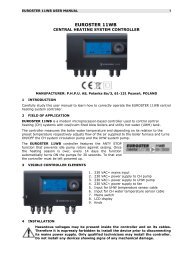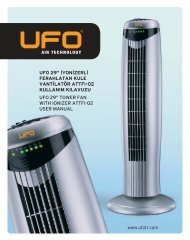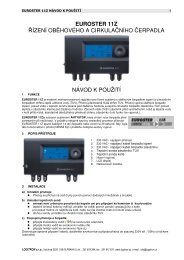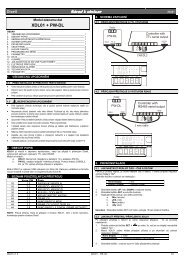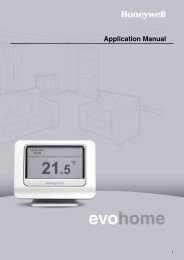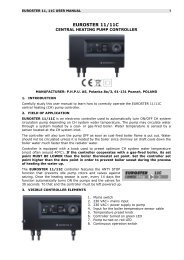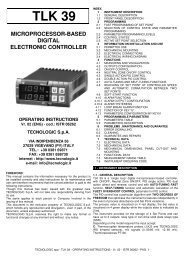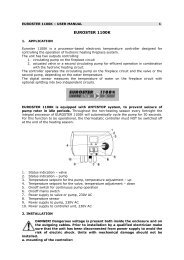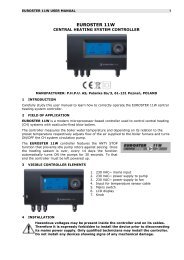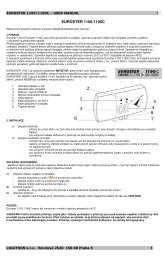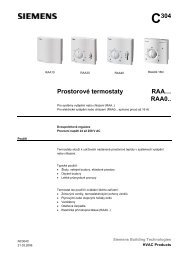The GD-04 âDavidâ GSM communicator - Jablotron
The GD-04 âDavidâ GSM communicator - Jablotron
The GD-04 âDavidâ GSM communicator - Jablotron
You also want an ePaper? Increase the reach of your titles
YUMPU automatically turns print PDFs into web optimized ePapers that Google loves.
1.2. David can be used as:<br />
• A switch with SMS remote control. SMS texts for switching particular terminals on/off are<br />
configurable.<br />
• A time-switch which can be activated remotely via a mobile phone (the switch-on period is<br />
configurable from 1 second to 10 hours).<br />
• A relay with dialling-in remote control. Up to 50 tel. numbers can be authorized for each<br />
relay. Because calls are not answered dialling-in control within <strong>GSM</strong> is free of charge. (David<br />
only checks the caller’s number and – if the number is authorized – responds with relay<br />
activation.) This can be used for parking latch control etc.<br />
• A relay with validity-limited dialling-in remote control. Each authorized number can have<br />
a limit to the number of calls. When the call count reaches the limit the tel. number is deauthorized.<br />
This can be useful for pre-paid services such as e.g. parking. Any tel. number can<br />
be re-authorized via SMS by the administrator.<br />
• An SMS reporter. Input A to D activations or deactivations can be reported by SMS and<br />
optionally confirmed by phone calls. Each input can have its own message texts and up to 8<br />
tel. numbers programmed.<br />
• Examples of David applications can be found on http://www.jablotron.cz/david/en/examples.htm<br />
1.3. David can be supplemented with:<br />
• A <strong>GD</strong>-<strong>04</strong>A back-up module, which provides David with the ability to work approx. 12 to 24<br />
hours continually without an external power supply, (see 11.1).<br />
• A <strong>GD</strong>-<strong>04</strong>D DTMF module, which allows you to control David’s output relays by entering<br />
numeric codes (DTMF codes) on the telephone keypad during calls, (see 11.2).<br />
• A <strong>GD</strong>-<strong>04</strong>P link cable, which allows you to connect David to a PC through a USB port and<br />
perform any desired configuration using <strong>GD</strong>Link software (see 11.4).<br />
• A <strong>GD</strong>-<strong>04</strong>R radio module, which allows input A to D activations via wireless buttons or<br />
detectors of the OASiS series and also provides David with the capability of output relay X or<br />
Y state transmission to UC or AC OASiS receivers. In addition, you can control relays X or Y<br />
“locally” via RC-8x keyfobs (so that an appliance can be controlled both via a mobile phone<br />
and a keyfob). <strong>The</strong> module also allows heating control (again locally or remotely via a mobile<br />
phone) using wireless thermostats of the TP-8x series (see 11.3).<br />
A detailed description of optional accessories can be found in chapter 11.<br />
2. David’s SIM card<br />
• In order to function, David needs a SIM card, preferably a tariffed one.<br />
• Test the SIM card by using it in your mobile phone – SMS sending and calling must work<br />
correctly.<br />
• Switch off the PIN code protection via the phone menu (or set the PIN code to 1234).<br />
• Check the <strong>GSM</strong> signal strength in David’s location.<br />
3. Installation<br />
1. <strong>The</strong> <strong>GSM</strong> antenna should not be shielded by metals. If necessary, an external antenna<br />
designed for the 900/1800MHz <strong>GSM</strong> band can be connected via a 50Ω SMA connector.<br />
2. Open the cover and release the electronic circuit board by pressing the tabs.<br />
3. Mount the rear plastic cover at the desired location.<br />
4. Insert a SIM card: Open the SIM card case by shifting the moving part in the direction of<br />
the terminals and tipping it off. Make sure that the card is correctly oriented and insert it.<br />
Close the SIM card case (fold and re-shift the moving part).<br />
<strong>GD</strong>-<strong>04</strong> DAVID 2 MKS51203<br />
Input A<br />
Input B<br />
Input C<br />
Input D<br />
Relay X<br />
Relay Y<br />
Input’s SMS reports<br />
SMS when activated<br />
SMS when deactivated<br />
Phone numbers<br />
SMS when activated<br />
SMS when deactivated<br />
Phone numbers<br />
SMS when activated<br />
SMS when deactivated<br />
Phone numbers<br />
SMS when activated<br />
SMS when deactivated<br />
Phone numbers<br />
Relays operation<br />
Wireless items *)<br />
David’s settings<br />
ON command SMS: DTMF code: *)<br />
OFF command SMS: DTMF code: *)<br />
Tel. numbers<br />
authorized for<br />
relay control<br />
ON command SMS: DTMF code: *)<br />
OFF command SMS: DTMF code: *)<br />
Tel. numbers<br />
authorized for<br />
relay control<br />
*) Only available for the <strong>GD</strong>-<strong>04</strong>D version<br />
Enrolled Type Device code Place<br />
Input A<br />
Input B<br />
Input C<br />
Input D<br />
Relay X<br />
Relay Y<br />
*) Only available for the <strong>GD</strong>-<strong>04</strong>R version<br />
<strong>GD</strong>-<strong>04</strong> DAVID 11 MKS51203



